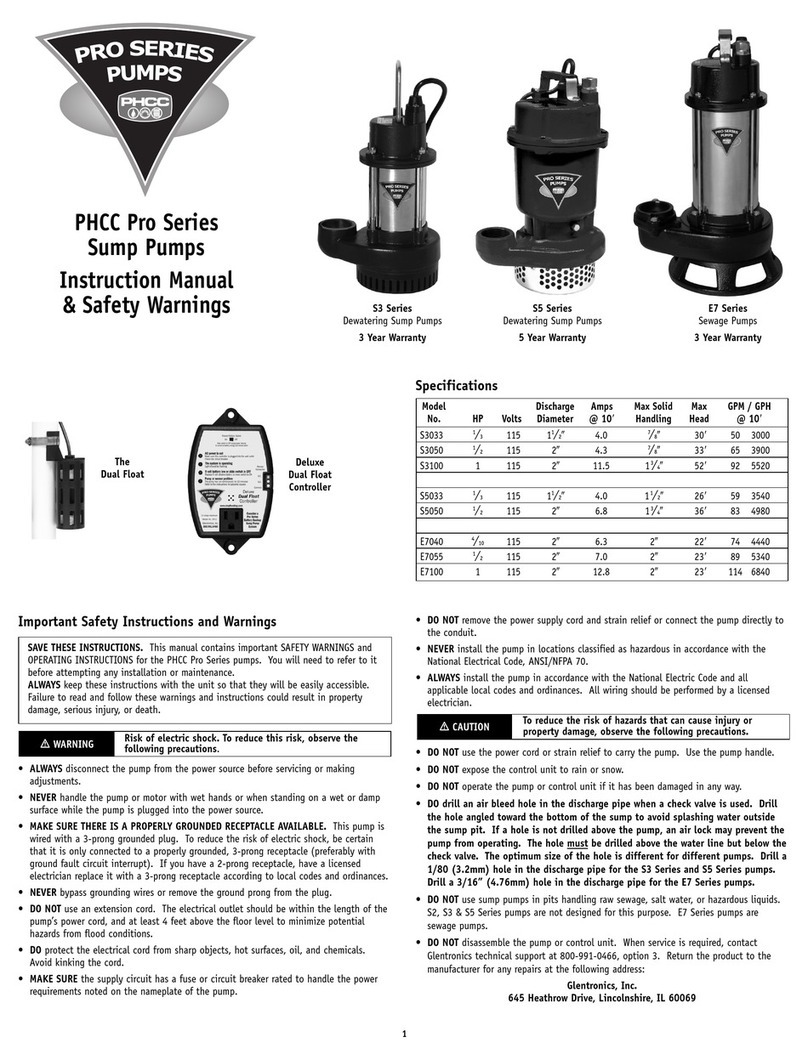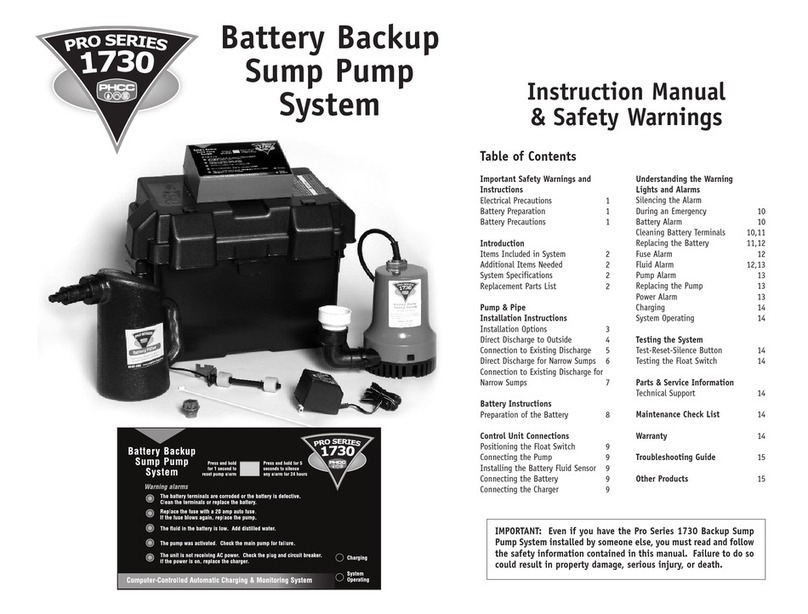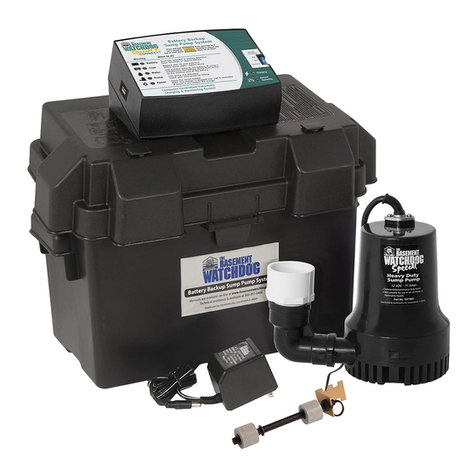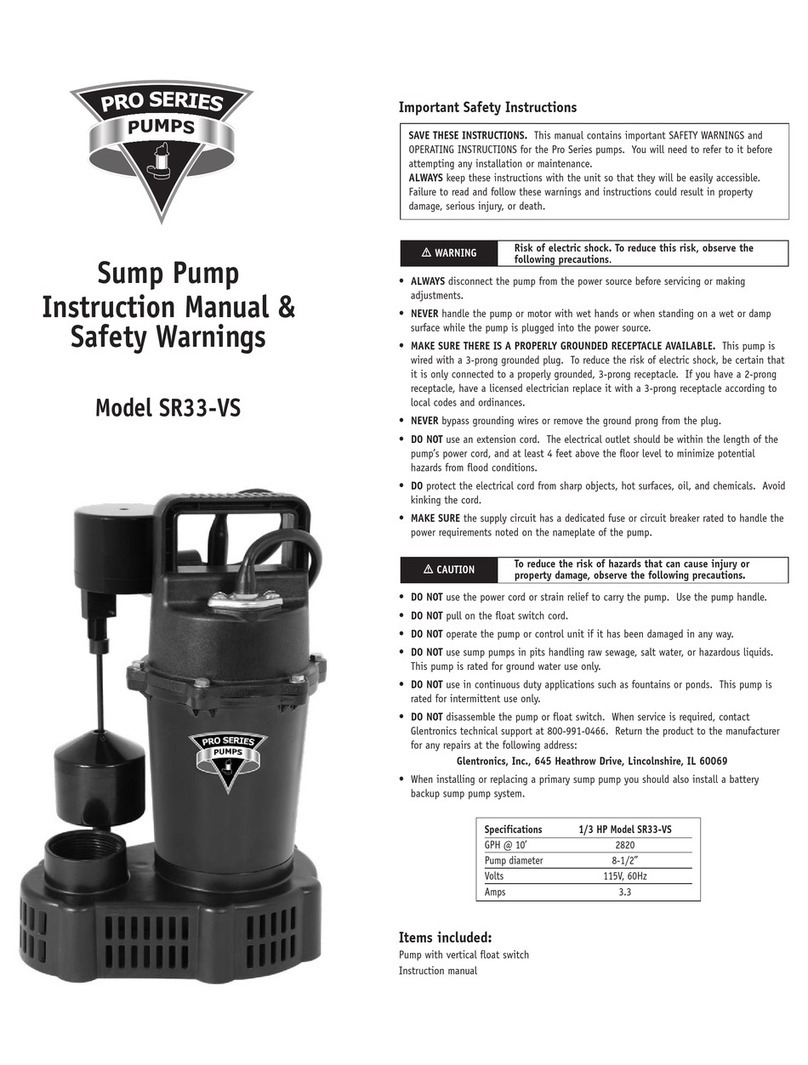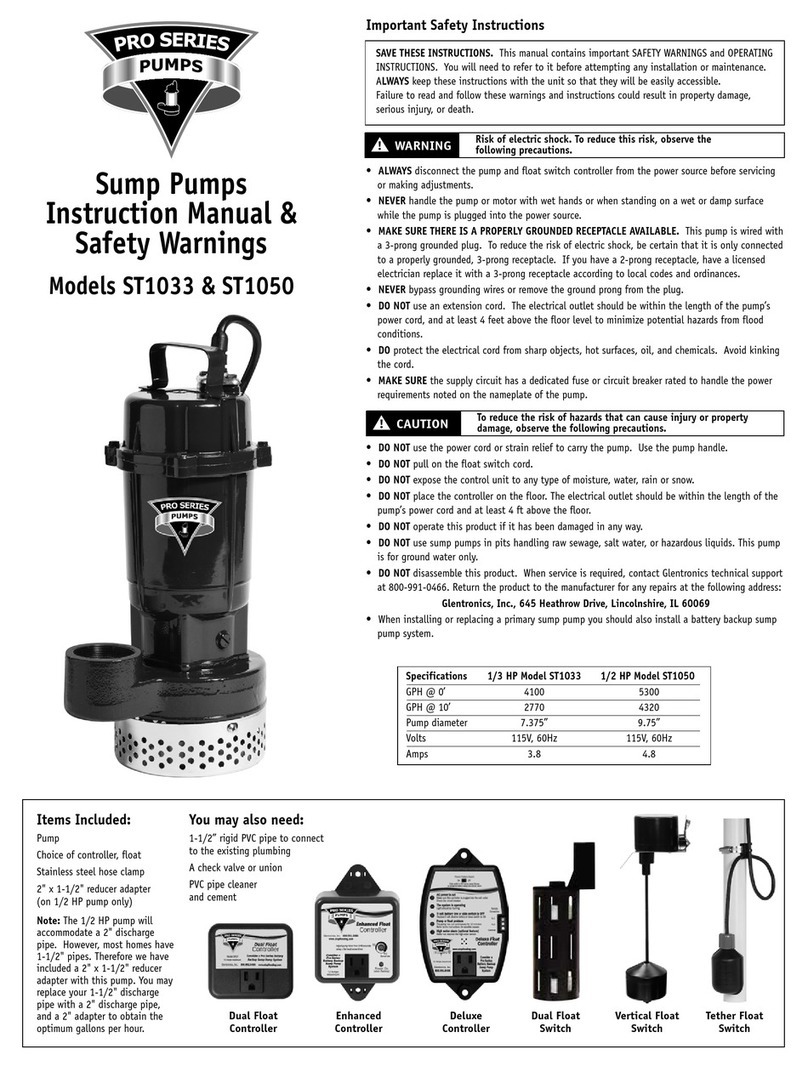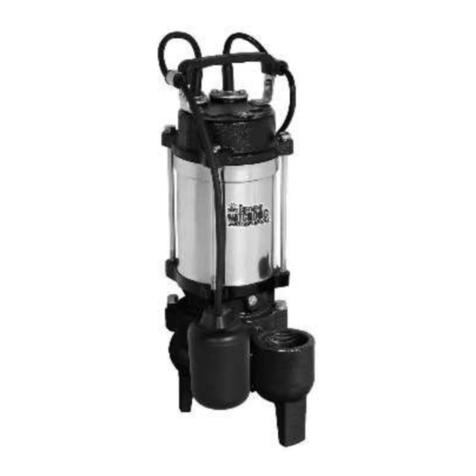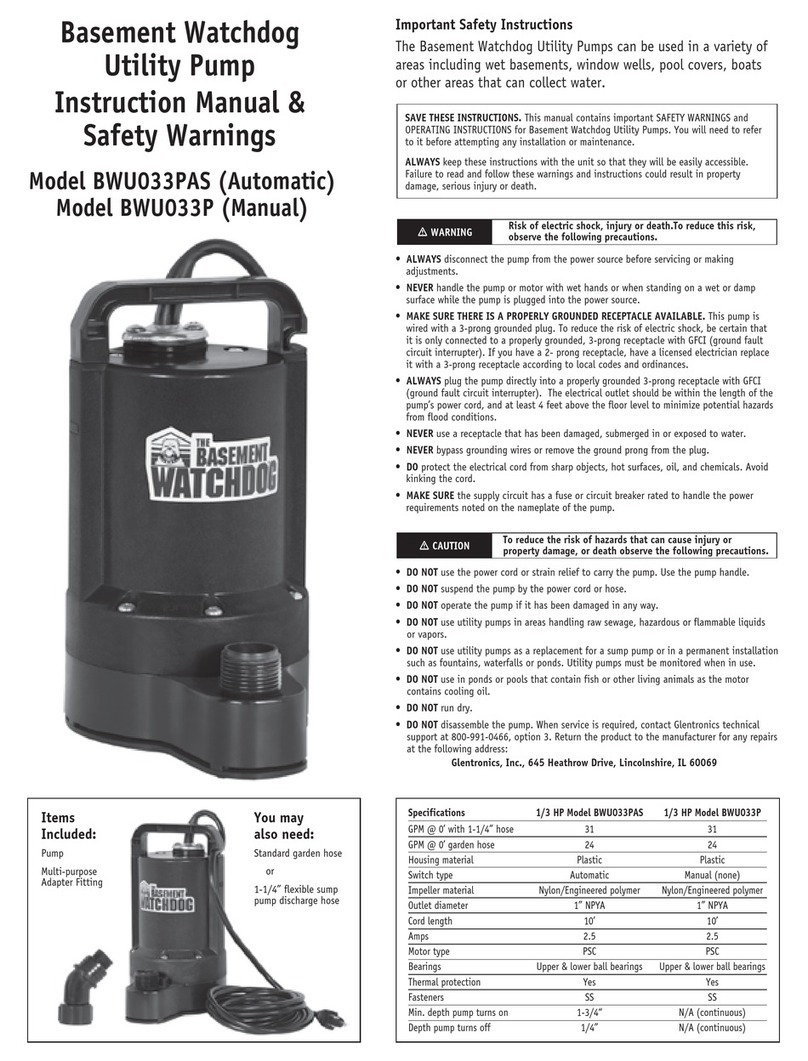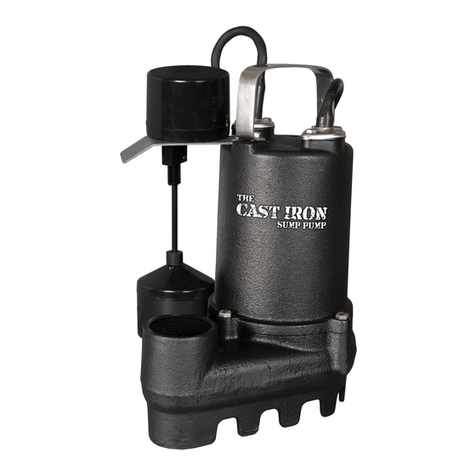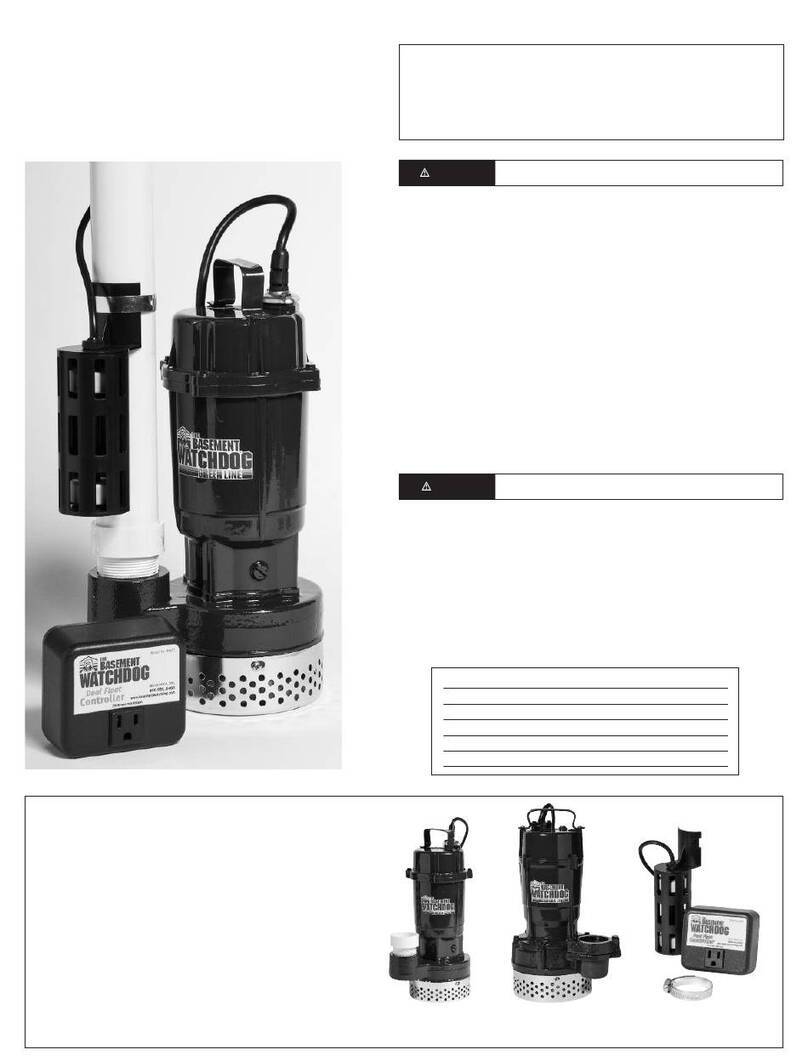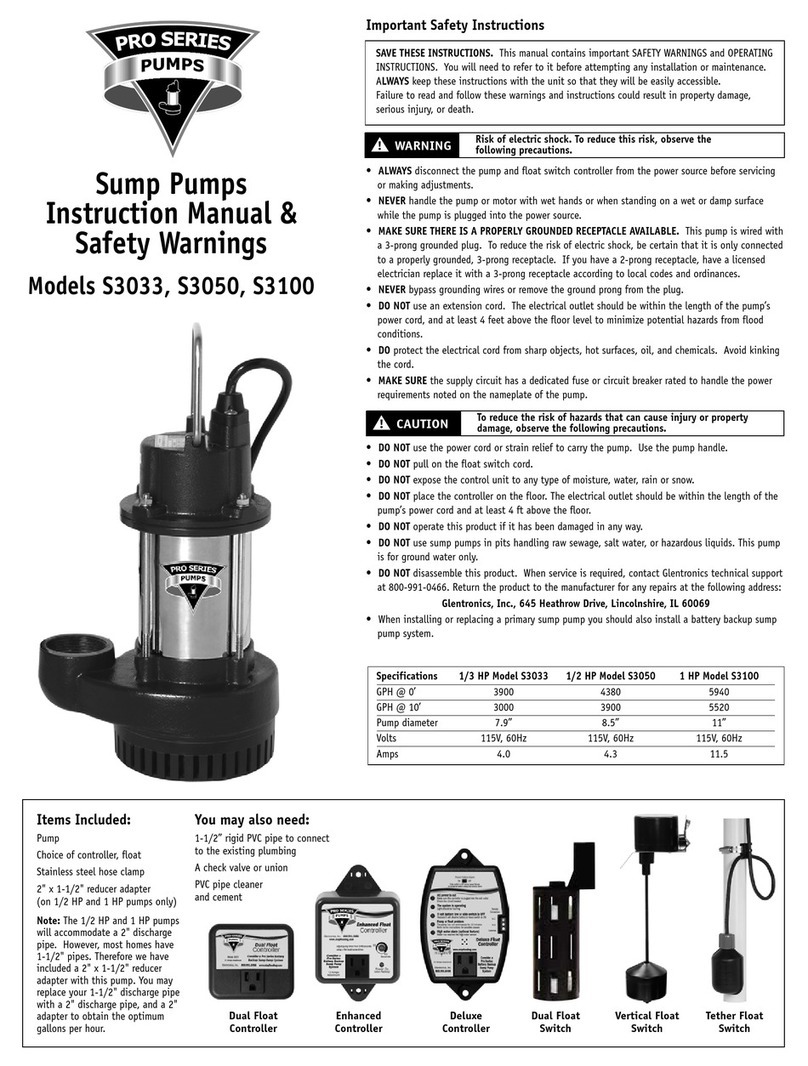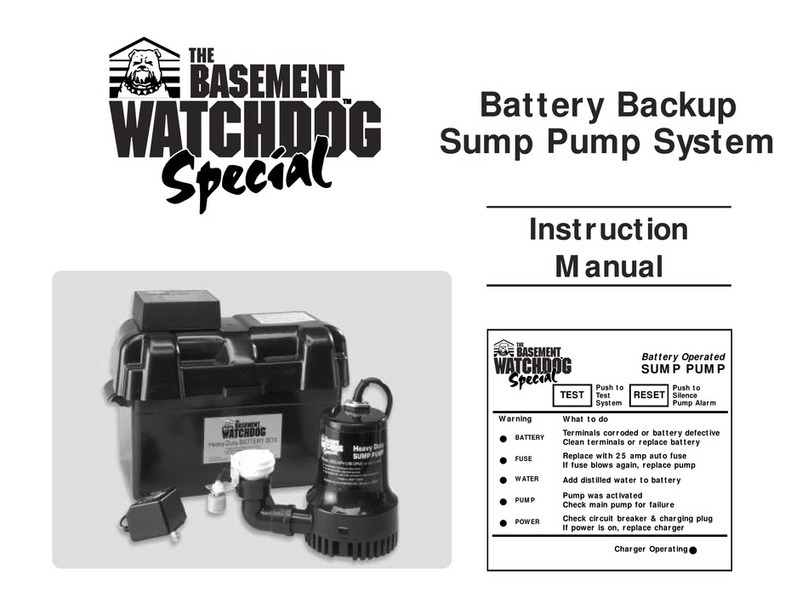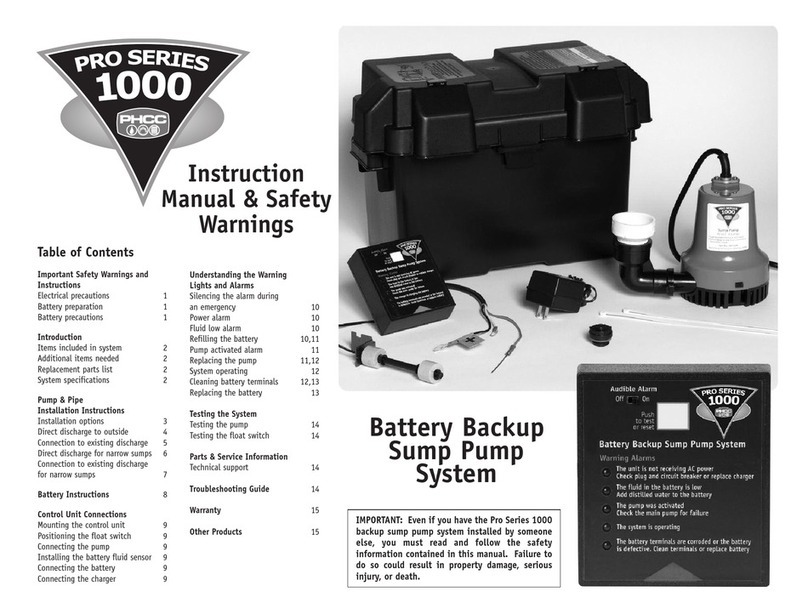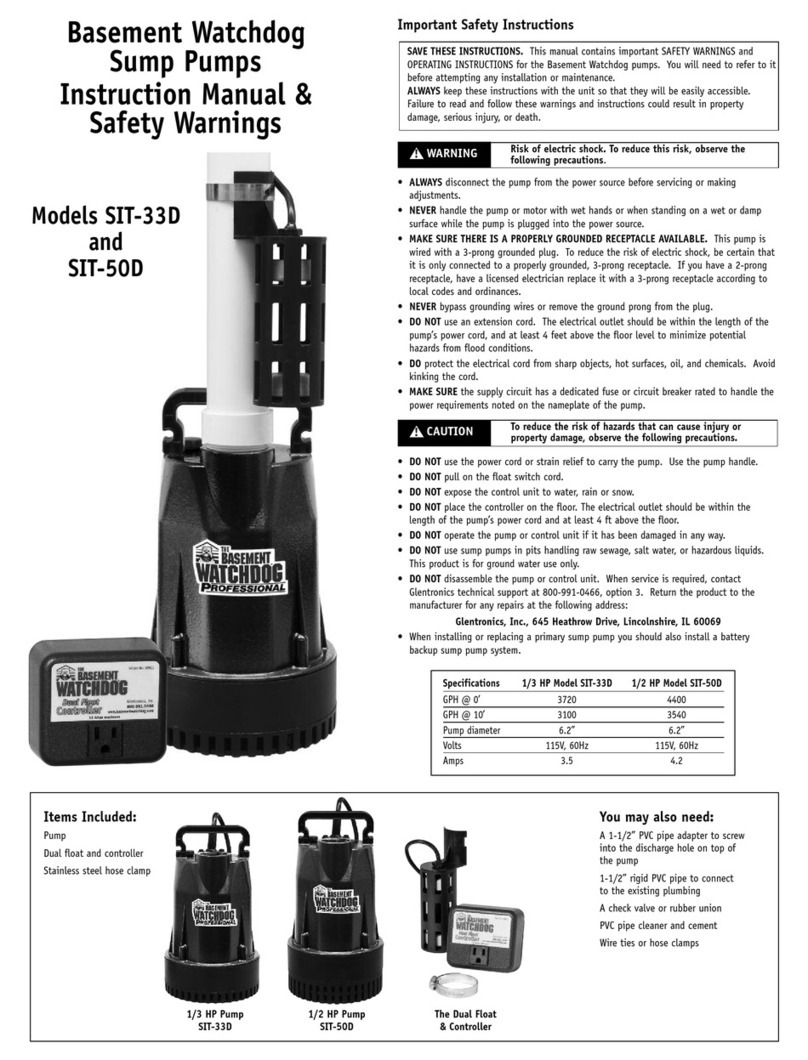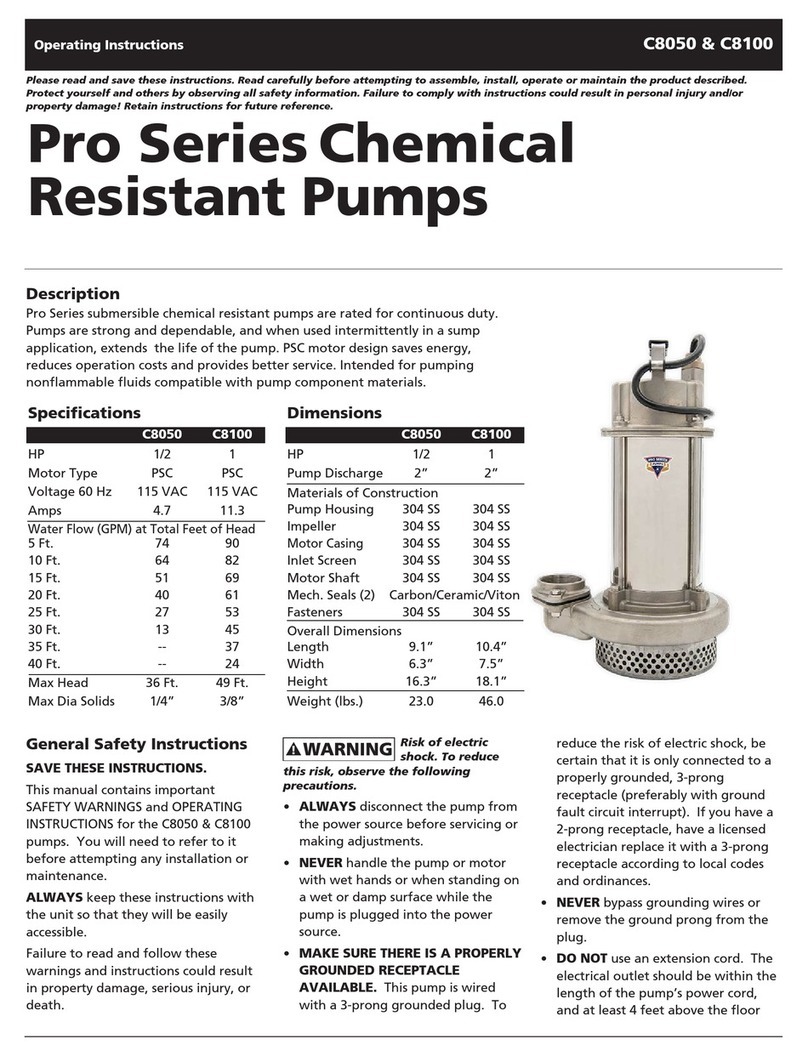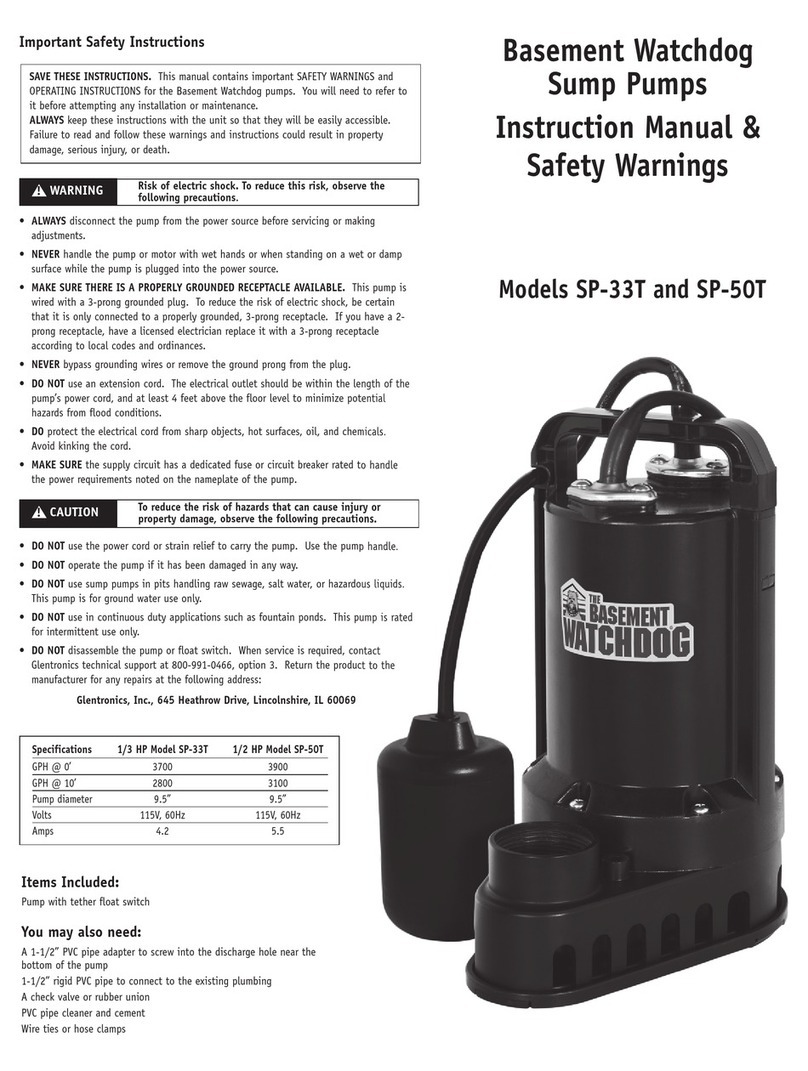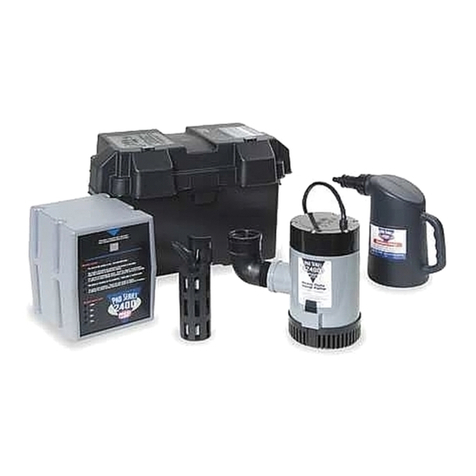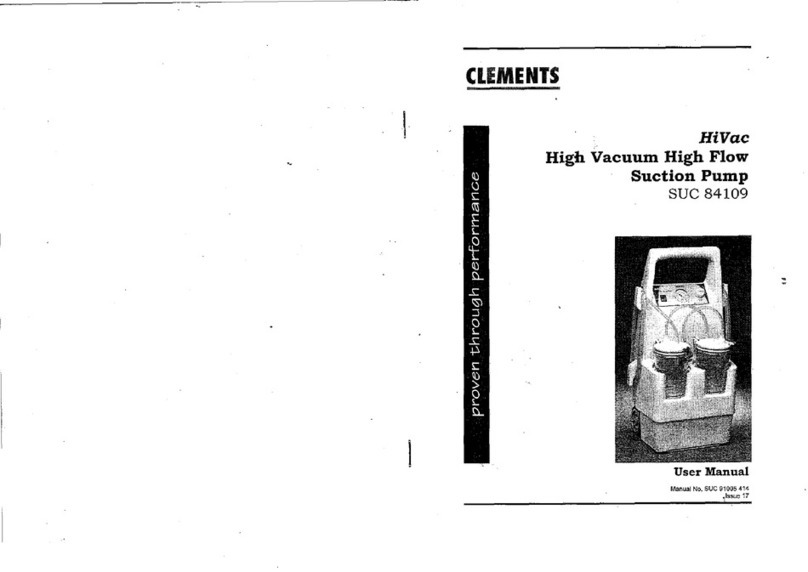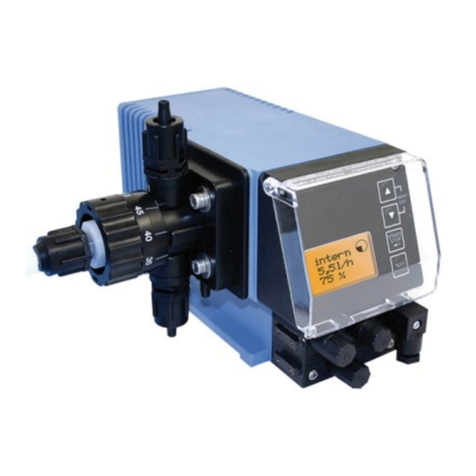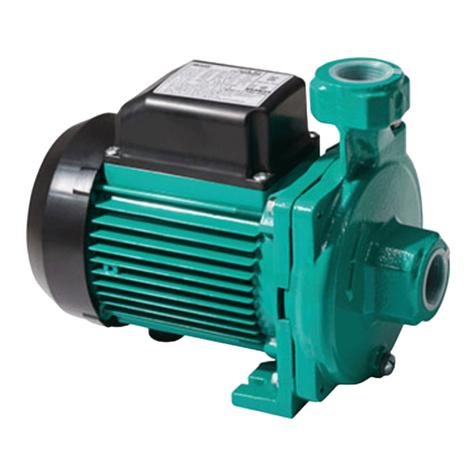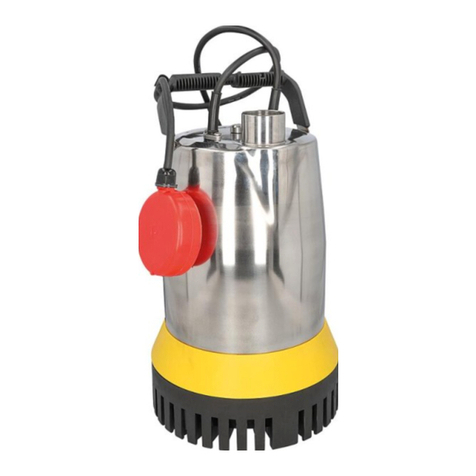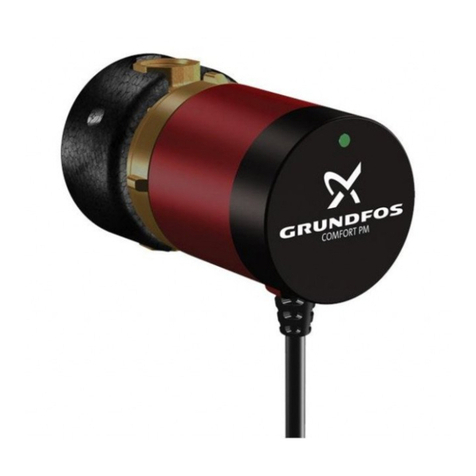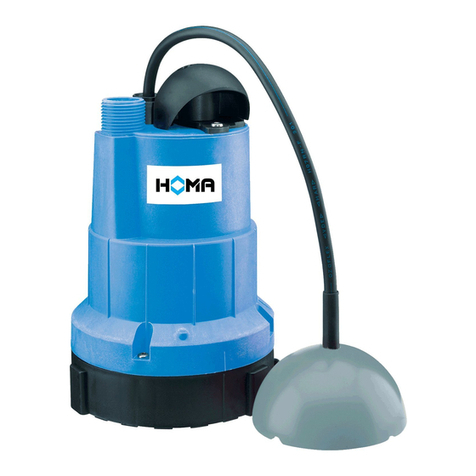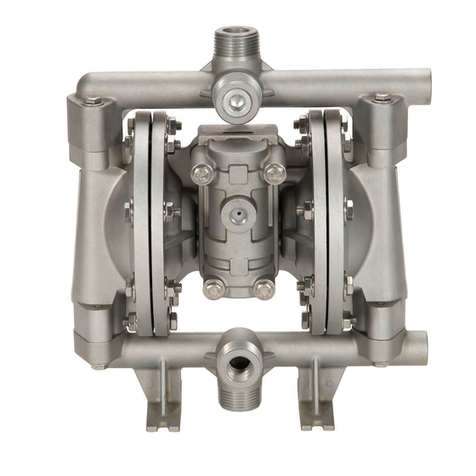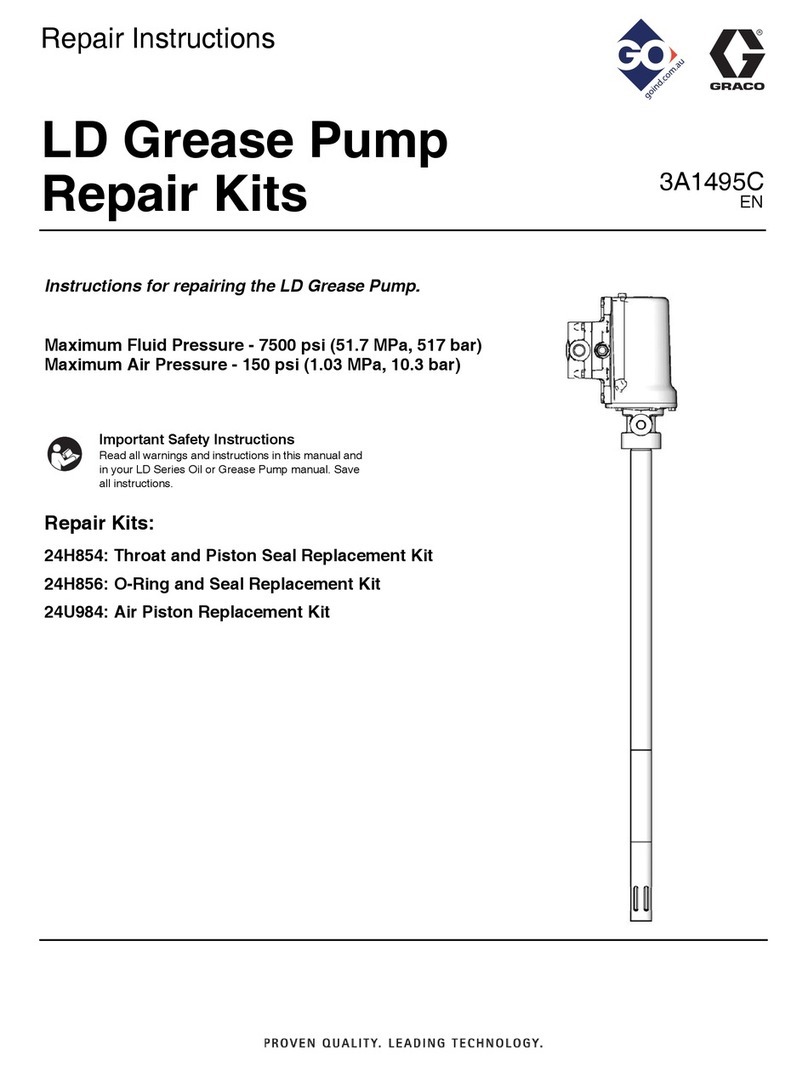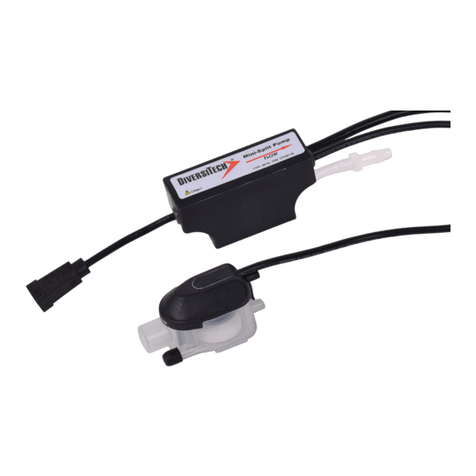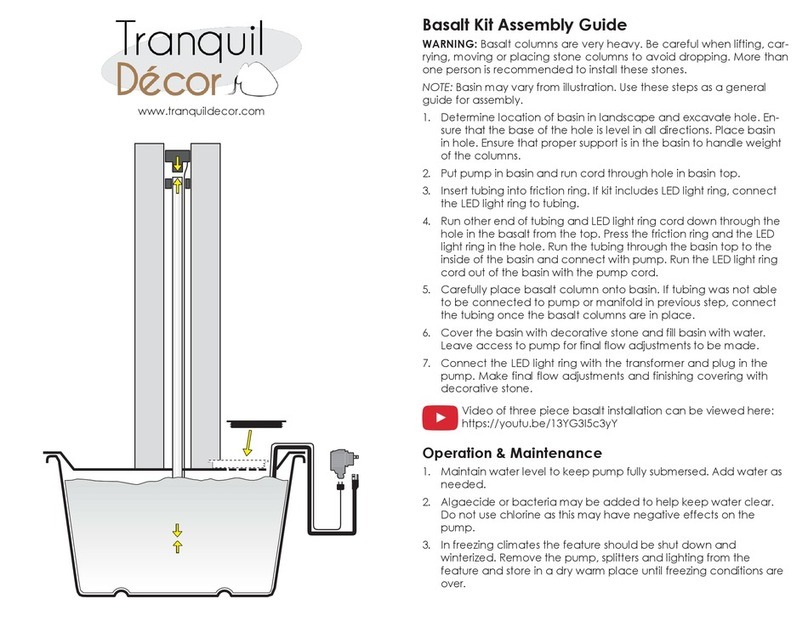
• When a check valve is used, a 3/16” (4.7 mm) air bleed hole must be drilled in
the PVC pipe above the pump. Drill the hole at a 45º angle toward the bottom
of the sump to avoid splashing water outside the sump pit. Make sure the hole
is above the water line, and below the check valve. If a hole is not drilled
above the pump, an air lock may prevent the pump from operating.
• The control unit must receive 115V AC +/- 5% and 60 Hz from the AC outlet.
• Primary pumps will not provide protection during a power outage. With the risk of
property damage from high water levels, the addition of a Pro Series battery backup
sump pump system is highly recommended.
• After the initial installation, be sure to check the operation by filling the sump with
water and observing the pump operation through several full cycles.
• In instances where the discharge line is exposed to freezing temperatures, the pipe
must be sloped downward so any remaining water will drain out. Failure to do so will
prevent water from exiting the sump and damage the pump if the line freezes.
Installation Instructions
Prior to Installation
1. Visually inspect your pump. Products may be damaged during shipping. If the
product has been damaged, contact your place of purchase or Glentronics, Inc.
before installation.
2. Thoroughly read the instructions provided to learn specific details regarding
installation and use. This manual should be retained for future reference.
Installing the Pump
1. Use a pit that conforms to all local codes
and is large enough to accommodate the
pump and float switch. Larger sump pits
are preferred, since they will extend the
discharge cycle and reduce the number of
times the pump turns on.
2. Clean the pit of all debris. The pump’s
strainer must be kept clear.
3. The pump should not be set directly onto a
clay, earthen, or sand base. Install bricks
or blocks under the pump to provide a
solid base.
4. The pump should be level.
5. Install discharge plumbing according to
local, regional and state codes. Rigid PVC
pipe is recommended.
6. An in-line check valve is recommended to
prevent back-flow. This check valve is
mandatory when sharing a discharge line
with another pump (i.e. a back-up pump or
a second primary pump).
(a) When a check valve is used, a 3/16”
(4.7 mm) air bleed hole must be drilled
in the PVC pipe above the pump. Drill
the hole at a 45º angle toward the bottom of the sump to avoid splashing water
outside the sump pit. Make sure the hole is above the water line, and below the
check valve. If a hole is not drilled above the pump, an air lock may prevent the
pump from operating.
7. Install a gate valve or ball valve if required by any codes.
8. The horizontal discharge pipe must be positioned in a downward slope so any
remaining water will drain away. Failure to do this will prevent water from exiting
the pit and damage the pump if the line freezes.
9. If you are replacing an old sump pump:
(a) Unplug the pump from the outlet.
(b) Loosen the check valve or rubber union by unscrewing the
bottom hose clamp. (If the existing system is installed
without a check valve or rubber union, saw the pipe apart
above the sump pit.)
(c) Remove the old pump and unscrew
the pipe and adapter.
(d) If the adapter fits into the new
pump, screw the pipe into the
pump. If not, cut a piece of rigid
PVC pipe and connect it to the
new adapter by cleaning and
cementing the two pieces
together. (Follow the instructions
on the PVC cleaner and cement.)
(e) Lower the pump into the sump by the handle.
(f) Connect the pipe on the pump to the existing discharge pipe with a rubber union
or check valve and tighten the hose clamps securely.
10. A pit cover is recommended for all installations as a safety measure and to help
prevent debris from falling into the pit. Be sure protect the cords from damage
when installing a pit cover.
Installing the Dual Float Switch
The Pro Series Dual Float Switch is easy to install by
using the enclosed metal hose clamp.
1. Hold the float switch to the discharge pipe so the
cage is below the bracket.
2. Secure the float to the pipe with the enclosed hose
clamp, but do not completely tighten the clamp at
this time.
3. Position the float switch to a level where the
bottom of the float cage is no lower than 50% of
the maximum height of the pump. To avoid debris
pouring into the float, it should be positioned on
the side of the discharge pipe opposite the drain tile.
Note: It is important to mount the float below the drain tile that empties into the pit.
Mounting it above the drain tile would allow water to fill the drain tile before the pump
is activated to pump out the water.
4. Once the float switch is in the desired position, tighten the clamp.
Installing the Vertical Float Switch
The vertical float switch contains a single large float.
Water will lift the float to the top of the lift rod which
will raise the lift rod and activate the pump. As the
pump evacuates the water from the pit the float will
drop, lowering the lift rod and turning off the pump.
Note: The vertical float switch must be moving
freely at all times. Make sure the float switch does
not come into contact with other pumps, wires,
pipe or any other object that may be in the sump
pit. The float switch must not come into contact
with the sump pit floor or wall. If the float switch
does not move freely the pump will not activate.
1. Fully open the metal hose clamp and insert it through the slots in the mounting
bracket of the float switch.
2. Place the hose clamp over the discharge pipe so that the gripping tabs are against
the pipe and select the desired activation level of the pump.
3. (a) When using the vertical float switch with either the Enhanced or Deluxe
Controller (Models VSC1.5 or VSC2), there are two rubber stoppers on the float switch
rod. Do not remove or alter their position as it will disrupt the timing of the
controller and how long the pump runs. (b) When using the vertical float switch
without a controller (Model VS), the pumping range can be adjusted by moving the
float stop up or down the lift rod. Note: It is important to mount the float so that the
activation level is below the drain tile that empties into the pit. Mounting it above the
drain tile would allow water to fill the drain tile before the pump is activated to pump
out the water.
4. To avoid debris from pouring onto the float, it should be positioned on the side of
the discharge pipe opposite the drain tile.
5. Once the float switch is in the desired position, securely tighten the hose clamp.
Note: The cable from the switch must remain outside the hose clamp.
Installing the Tether Float Switch
The tether float contains a single float connected to a flexible tether. Water will raise
the float to activate the pump. As the pump evacuates the water from the pit the float
will fall and turn off the pump. Note: The tether float switch must be moving freely
at all times. Make sure the float switch does not come into contact with other
pumps, wires, pipe or any other object that may be in the sump pit. The float
switch must not come into contact with the sump pit floor or wall. If the float
switch does not move freely the pump will not activate.
1. Locate the desired activation point. Note: It is important to mount the float so that
the activation level is below the drain tile that empties into the pit. Mounting it above
the drain tile would allow water to fill the drain tile before the pump is activated to
pump out the water.
2. Secure the float to the pipe with the enclosed hose
clamp and bracket. Be sure the bracket is positioned
as shown. Do not overtighten the hose clamp.
Overtightening may cause damage to the mounting
bracket.
3. To avoid debris from pouring onto the float, it should
be positioned on the side of the discharge pipe
opposite the drain tile. Note: DO NOT adjust the tether length to less than 4” as this
can cause excessive stress on the cable or prevent the switch from operating.
Connecting the Pump and Controller
Dual Float Controller
Plug the control box into a properly grounded,
3-prong receptacle, then insert the pump plug into
the receptacle on the control box.
For a neater installation, secure the power cord and
the float switch cord to the discharge pipe with
wire ties or hose clamps. Keep the cords separated
from each other on opposite sides of the pipe.
Enhanced Controller
1. Mount the controller to the wall through the 2
holes on the cabinet using proper mounting
hardware for the application. The controller
should be mounted at least 4’ from the floor and
1’ from the outlet.
2. Check to ensure the float switch is connected to
the controller. The float switch wire of the
Enhanced Controller includes a connector that
can be separated from the controller when the
wire needs to be threaded through small
openings. When used with the Enhanced
Controller, the dual float switch has a safety
locking pin. This pin will prevent the float switch from accidently being
disconnected from the controller. Check to ensure the safety locking pin is inserted
through the connector.
3. Plug the control box into a properly grounded, 3-prong receptacle. Then, plug the
pump into the receptacle on the control box. Do not use an extension cord.
4. Using a flathead screwdriver, adjust the dial on the front of the controller to select
the number of seconds that the pump will run after the float drops. The dial can be
adjusted from 5-45 seconds. The manufacturer default is about 10 seconds.
Deluxe Controller
1. Mount the controller to the wall through the 2 holes on the cabinet using the proper
mounting hardware for the application. The controller should be mounted at least 4’
from the floor and within 2’ of the outlet.
2. Check to ensure the float switch is connected to the controller. The float switch wire
of the Deluxe Controller includes a connector that can be separated from the
controller when the wire needs to be threaded through small openings. When used
with the Deluxe Controller, the dual float switch has a safety locking pin. This pin
will prevent the float switch from accidently being disconnected from the controller.
Check to ensure the safety locking pin is inserted through the connector.
3. Open the plastic door on the top of the Deluxe Controller and using a flat head
screwdriver adjust the dial to select the number of seconds that the pump will run
after the float drops. The timer can be adjusted from 5-45 seconds. The manufacturer
default is about 10 seconds. Install a 9V alkaline battery and replace the plastic door.
4. Plug the control box into a properly grounded, 3-prong receptacle. Then, plug the
pump into the receptacle on the control box. Do not use an extension cord.
5. Make sure the Power Failure Alarm slide switch is in the ON position.
Connecting to a Security System (Deluxe Controller Only)
The Deluxe Controller includes a terminal on the right side of the control box to connect
to a security system or other alarm devices. There are (3) three positions for wire
connections on this terminal: N.O. – normally open, N.C. – normally closed, and
Common.
1. Check your security system to determine whether an open (no contact) or closed
(making contact) connection is needed to activate the alarm.
2. The security system will provide (2) two connection terminals to extend wires to the
control terminal. Strip two wires 1/4” each. Connect either wire to the common
terminal. To secure the wire into the terminal, insert the exposed wire into the hole
on the side of the terminal next to the screw marked common. Turn the screw a few
turns to lock-in the wire.
3. If the security system requires a closing of a contact to activate the alarm, secure
the other wire into the terminal hole labeled N.O. (normally open). If the security
system requires an opening of a contact, secure the wire into the terminal hole
labeled N.C. (normally closed).
Connecting the Pump and Float Switch (Models VS and TS – No Controller)
1. Plug the float switch cord into a properly grounded 3-prong receptacle. Then, plug
the pump into the receptacle on the float switch cord. Do not use an extension cord.
Completing the Installation (all models)
1. After the initial installation, be sure to check the pump operation by filling the sump
with water and observing the pump through several full cycles. When using the
Enhanced or Deluxe Controllers, the pump should run for 10 seconds after the lower
float drops. Note: When the pump activates, it should have a “normal pumping”
sound. Any abnormal sound, vibration, or lack of output is the signal of a problem.
Stop the pump and refer to the troubleshooting guide. The vertical and tether float
switch must be moving freely at all times. Make sure the float switch does not
come into contact with other pumps, wires, pipe or any other object that may be
in the sump pit. The float switch must not come into contact with the sump pit
floor or wall. If the float switch does not move freely the pump will not activate.
2. Replace the pit cover making sure not to pinch or crimp the pump wire with the
cover. The pit cover either has a ‘hole punch’ that will allow the cord to be passed
through or one can be drilled in the cover.
Product Operation
Dual Float Switch
The dual float switch contains two large floating rings enclosed within a protective cage.
Water will lift the bottom float by a 1⁄4”, which will activate the pump. If for any
reason the lower float does not activate the pump, the water will rise and activate the
second switch. As the pump evacuates the water from the pit the floats will drop. The
pump will run for an additional 10 seconds to extend the cycle after the lower float
drops. When using the Dual Float Switch with the Enhanced or Deluxe controller, the
float switch wire will include a connector that can be separated from the controller when
the wire needs to be threaded through small openings. The float switch connector has a
safety locking pin. This pin will prevent the float switch from accidentally being
disconnected from the controller. To remove the pin, push the pointed end of the pin
into the float connector and pull it out from the other end. The float switch wire can
now be disconnected. Make sure to reinstall the pin after the float switch is reconnected.
Note: When mounting the float switch, position the bottom of the cage at the height you
want the pump to activate.
Vertical Float Switch with Enhanced or Deluxe Controllers
The vertical float switch contains a single large float. Water will lift the float by a 1⁄2”,
which will activate the pump. As the pump evacuates the water from the pit, the float
will drop. The pump will run for an additional 10 seconds to evacuate the pit completely
after the float drops. Note: There are two rubber stoppers on the float switch rod. Do not
remove or alter their position as it will disrupt the timing of the controller and how long
the pump runs. Note: When mounting the float switch, position the bottom of the float at
the height you want the pump to activate.
Tether Float Switch with Enhanced or Deluxe Controllers
The tether float contains a single float connected to a flexible tether. Water will raise
the float to activate the pump. As the pump evacuates the water from the pit the float
will fall and the pump will run for an additional ten seconds to empty the pit. Note: The
tether float switch must be moving freely at all times. If the float switch does not move
freely the pump will not activate.
Dual Float Controller
The Dual Float Controller will activate the pump when either float is lifted, and then
shuts off automatically 10 seconds after the float drops. Plug the pump cord into the
piggyback switch on the control unit.
Enhanced Controller
The Enhanced Controller features a dial to adjust the number of seconds that the pump
will run after the float drops. The dial can be adjusted from 5-45 seconds. The
manufacturer default is about 10 seconds. The LED on the front of controller will signal
the unit is receiving power. The controller will also run the pump once a week for
approximately four (4) seconds. This test will exercise the pump and help ensure the
pump is working properly.
Deluxe Controller
The Deluxe Controller features a series of
warnings (audible and visual) that pinpoint
potential problems with the pump, switch and
power conditions. The controller will sound an
alarm when power has been interrupted, when
the pump has run for more than 10 minutes
continuously, or when the 9V battery is low. The
9V battery (sold separately) runs the controller
during a power outage, allowing it to sound an
alarm if the circuit breaker trips, the controller is
not plugged in securely, or the home’s power is
interrupted. Note: The 9V battery will only power
the controller, not the pump. The Deluxe
Controller is equipped with a USB data port. The purpose of this port is to allow
communication with the Pro Series Connect Modules. The Pro Series Connect Modules are
separately sold accessories that will allow the user to stay connected and receive remote
notifications of potential problems and needed maintenance while away from home. The
Deluxe Controller has a dial (located in the battery compartment) to adjust the number
of seconds that the pump will run after the float drops. The Deluxe Controller will also
run the pump once a week for approximately four (4) seconds. This test will exercise the
pump and help ensure the pump is working properly.
Understanding the Warnings & Alarms - Deluxe Controllers
AC power is out
There are several causes for power failure. The most common causes are a power outage
by the electric company or a tripped circuit breaker. Although the deluxe controller can
not run the pump, it will sound an alarm indicating the loss of power. This will allow
3
the homeowner to address the problem.
If this warning light and alarm are on, the control box is not receiving AC power for one
of many reasons:
1. The control box is not plugged in
2. The power to the house is out
3. The circuit breaker to that outlet has been tripped
4. The ground fault interrupter on that outlet has been tripped
5. A power brownout is taking place
Power Failure Alarm slide switch
When the controller is not receiving AC power, the monitoring features and the audible
alarms are powered by the 9-volt battery. This type of battery will power the controller
for many hours, but not indefinitely. Once the source of the AC power alarm is
determined, it is suggested that the Power Failure Alarm slide switch be turned to the
OFF position until the power is restored. This will preserve the battery and silence the
alarm. When AC power is restored, slide this switch back to the ON position. Note: If
the AC power is restored and the slide switch is in the OFF position, the alarm and light for
the 9-volt battery warning will activate, even if the battery is good. This is a reminder to
reset the alarm. Slide the switch to the ON position. If the battery is good, the light will
go out. If the alarm continues to sound, replace the battery.
The system is operating
This light should be ON and flashing at all times. It is included to indicate that the
system is monitoring the sump conditions. This light will not illuminate when:
1. The power is out and the Power Failure Alarm slide switch is in the OFF position
2. The power is out and the 9V battery is discharged
3. The controller is not functioning. Contact the Glentronics service department
The 9-volt battery low or slide switch is OFF
1. The 9-volt battery located in the top of the control box is coming to the end of its
useful life. Replace it with a new 9-volt alkaline battery.
2. The Power Failure Alarm switch is in the OFF position. It must be in the ON position
at all times, except when silencing an actual power failure condition.
Pump or float problem
This key feature monitors the time that the float switch is up continuously or in the
activated position. It is unusual for a pump run for 10 or more minutes continuously.
This can occur for many different reasons. Either the float is stuck in the up position,
there is a mechanical problem with the pump, or there is a problem with the plumbing
connections. Please refer to the Troubleshooting Guide on page 5.
High water alarm (optional feature*)
When water reaches the optional water sensor, it will activate the warning light, audible
alarm, and remote terminal. The activation of the water sensor could indicate that there
is a failure of the main pump or plumbing problem. Please refer to the Troubleshooting
Guide on page 5.
*This feature requires the additional purchase of the water sensor (Model PS-WS).
Accessories for the Deluxe Controller –
Connect Modules and High Water Alarm
Connect Modules - WiFi Module – Home Automation Module
(Requires purchase of PS-WiFi or PS-HZM)
The Deluxe Controller is equipped with a USB data port. The purpose of this port is to
allow communication with the Pro Series Connect Modules. The Pro Series Connect
Modules are separately sold accessories that will allow the user to stay connected and
receive remote notifications of potential problems and needed maintenance while away
from home.
High Water Alarm - Accessory for the Deluxe Controller
(Requires the additional purchase of Model PS-WS)
Water Sensor
The water sensor is designed to warn you of a potential flood. If you are installing it in
the sump pit, it must to be installed between the basement floor and the primary float
switch. If there is a failure with either the main pump or the plumbing system, the water
level will rise past the primary float switch and activate the water sensor. When the
water sensor is activated, it will trigger a warning light, an audible alarm, and the
remote terminal on the controller. This water sensor is only designed to give you a
warning of a potential problem; it will not activate the primary pump.
Maintenance Check List
Maintenance should be performed 1-2 times per year.
1. Remove all debris from the bottom of the pit and make sure the
pump’s strainer is clear of debris.
2. Remove all debris floating in the water.
3. Remove all debris from the float switch and float switch cage.
4. Fill the pit with water. Make sure pump turns on at the intended level.
5. While the pump is running, make sure pump is evacuating water at a good pace.
6. While the pump is running, make sure a stream of water is escaping from the air
bleed hole. If not, clear the hole of any deposits or debris.
Backup Installation
When the power goes out, the
Pro Series AC sump pump will not
operate. For protection during a
power outage, a Pro Series battery
backup system should be installed.
There are three systems with
matching batteries that will
provide protection. The
illustration at right is an example
of a typical battery backup
installation.
! WARNING
Make sure the outlet is single phase, 115V and 60HZ
for all the pump installations.
Slide switch to OFF during power failures
to conserve battery energy and silence alarm
Power Failure Alarm
Remote
Connection
N.C.
Common
N.O.
Glentronics, Inc.
800.991.0466
www.stopflooding.com
Model No. DFC2
On Off
12 Amps maximum
Consider a
Pro Series
Battery Backup
Sump Pump
System
AC power is out
Make sure this controller is plugged into the wall outlet
Check the circuit breaker
The system is operating
Light should be flashing
Pump or float problem
The pump has run continuously for 10 minutes
Refer to the instructions for possible causes
High water alarm (optional feature)
Water has reached the high water sensor
9 volt battery low or slide switch is OFF
Replace 9 volt alkaline battery or move switch to ON
Deluxe






